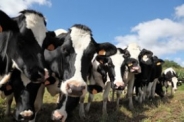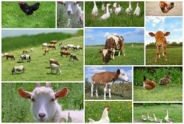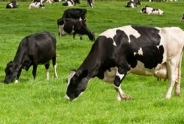Heat Stress - the Rest of the Story
Jerry Bertoldo, Dairy
Northwest New York Dairy, Livestock & Field Crops
Last Modified: June 25, 2013
The weather has been on everyone's mind and in our conversations since spring - from endless rains to now parching sun and heat. Milk production has suffered across the board. Those armed with fans, misters or soakers or a combination of these, have had the least impact on herd production. Minimal or no heat abatement has resulted in milk losses of 10-20%.
Not designed for the heat
Cows are biological factories with a heat generating rumen as part of their powerhouse. In one day, they give off the same heat as a 1500 watt electric hair dryer running for one hour. Cows have limited ability to sweat. Their surface area is small compared to the body mass. Radiating excess heat is not very efficient. Much heat loss must occur through breathing. Cows have a need to dump extra body heat when ambient temperatures exceed 68°F. High humidity makes the job tougher.
We most easily see the evidence of this overheating in decreased dry matter intake and lower milk production. Panting increases standing time and crowding develops as the situation worsens. Prolonged heat stress will limit the expected recovery in pounds of milk in mid to late lactation cows and dampen the peak milk for early lactation ones.
Heat stress with consequences occurs in cattle when body temperatures exceed 103°F, respirations are more than 80 per minute, feed intake drops more than 10-15% and milk production decreases the same. The efficiency of energy utilization for milk production may drop 30-50% as well.
Immediate and delayed consequences
The effects of heat stress are more numerous than these previous observations. Body temperatures over 103°F for several hours are lethal to embryos and reduce the effects of vaccinations. Birth weights are lower when the calf is carried through the last trimester in hot conditions. Colostrum quality is lower. Body condition is harder to maintain. Laminitis is more common after hot weather. Metabolic problems occur more frequently in transition cows during these conditions. Ketotic cows have reduced fertility two months after the episode. Immune function suffers after heat stress resulting in more mastitis, retained placentas and metritis.
Laminitis is a big dollar issue
Cattle trend towards erratic eating patterns and less cud chewing during heat stress. This leads to lower saliva production and rumen pH. Drooling of bicarbonate rich saliva during extreme heat wastes this buffer when it is needed the most. Panting contributes to the acidosis picture by lowering blood pH. Higher rumen acidity ulcerates the rumen lining opening a way for harmful toxins and bacteria to enter the bloodstream and promote the release of powerful chemicals that inflame the soft tissues inside the hoof. This is how chemically induced laminitis happens. The result is at first the bruised appearance of the sole followed by white line and heel separations, sole ulcers and abscesses. Eventually the fever rings and misshapen hoof walls become apparent.
From a purely mechanical point of view, it is fairly common to see laminitis after cows have experienced long periods of standing versus lying down compared to the ideal 12 hours plus off their feet. Overcrowding is often the cause. This occurs in all weather conditions; however the severity of the situation is much more dramatic when putting the metabolic changes of heat stress on top.
The signs of laminitis start with stiffness in gait and evolve to more dramatic lameness. Telltale signs of sole discoloration take up to two month to show, matching the growth rate and thickness of the sole layer. Continued insult to the sensitive areas in the hoof compound the problem. These cows become difficult to keep sound and productive.
Silent time bombs
The entry of bacteria into the bloodstream through the "burnt" rumen wall provides the culture for abscesses as well as chemical changes affecting the feet. Unlike other species, cattle tolerate this level of bacteria quite well. The same load of bugs would undoubtedly make us severely ill in the least.
These bacteria travel and set up housekeeping in other places as well in the cow. The lung and liver are two prime spots. Abscesses can develop and enlarge over time. Chronic rumen acidosis can be associated with sudden death from the rupture of these pus pockets. When this occurs in the lungs, bleeding from the nose is a common sign. Other cases wind up being poor doers without a diagnosis.
Cause and effect
With the time span between heat stress and a good deal of the aftermath being long, it is easy to look for other reasons to explain problems that come up in the fall. It is late to do much about heat abatement for this year, but it is not too early to think about what you can do to for next. Keep a mindful eye on the performance of your herd in the months ahead and see if it fits with the heat stress "rest of the story". There is a big dollar opportunity in providing extra cool comfort to cows in the summer.
Upcoming Events
2026 Corn Congress
January 14, 2026
Henrietta, NY
Participant Registration for the 2026 Corn Congress NOW OPEN!
NOW OFFERING 1.5 DEC Recertification CREDITS
2026 Forage Congress
January 28, 2026
Nunda, NY
Vendor Registration 12.08.25
2026 Soybean & Small Grains Congress
February 11, 2026
Henrietta, NY
Announcements
The NWNY Team is Hiring!
The NWNY Dairy, Livestock and Field Crops Team is currently looking for an Area Dairy Management Specialist as well as a Small Farms and Livestock Specialist:The full position descriptions and instructions on how to apply are available here:
Area Dairy Management Specialist: https://academicjobsonline.org/ajo/jobs/31178
Small Farms and Livestock Specialist: https://academicjobsonline.org/ajo/jobs/30979
Follow us on Instagram
See photos and reels of our most recent events and programs!Join us on Facebook!
Follow us on Facebook to get up to date posts about events, workshops and everything NWNY!Add us on LinkedIn!
Connect with us on LinkedIn to get more information about upcoming workshops and programs!





